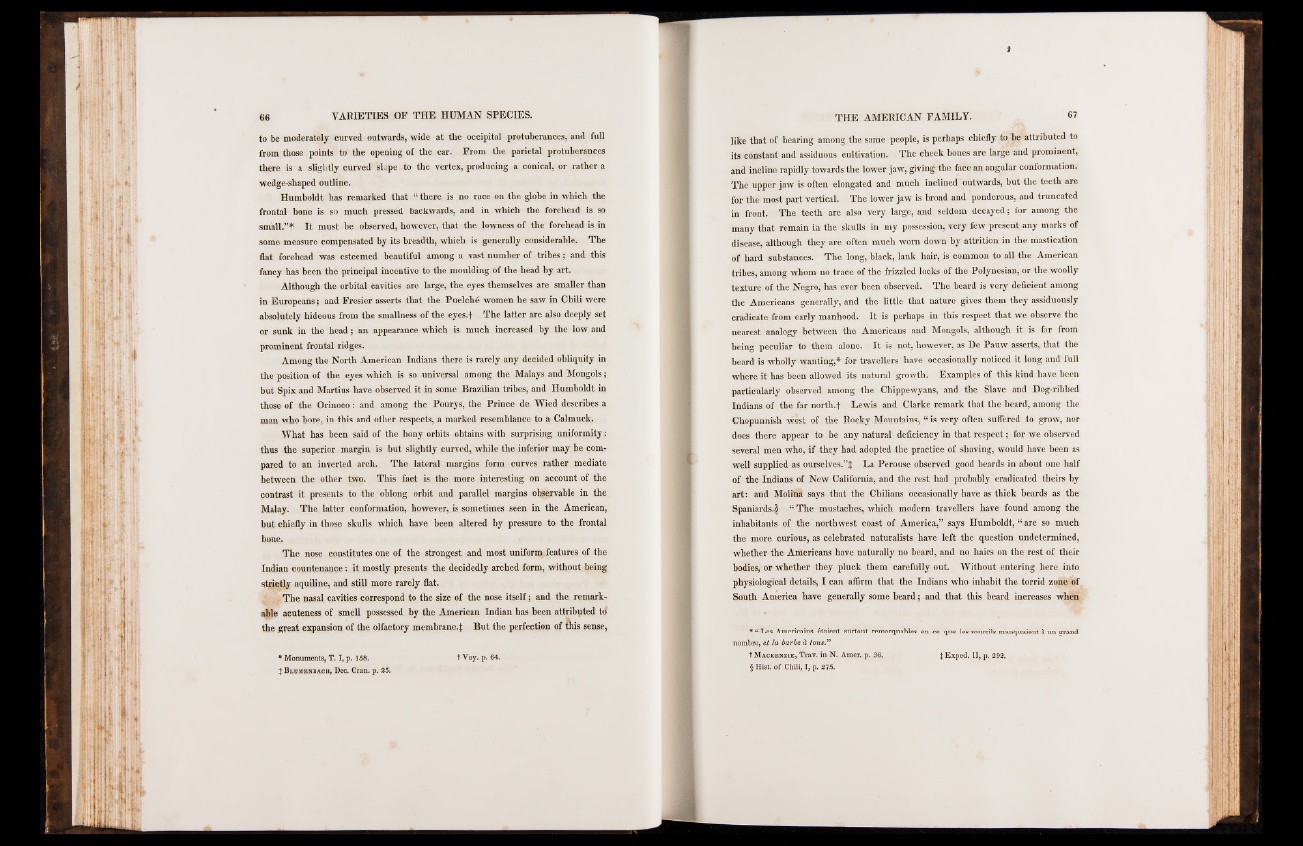
to be moderately curved outwards, wide at the occipital protuberances, and full
from those points to the opening of the ear. From the parietal protuberances
there is a slightly curved slope to the vertex, producing a conical, or rather a
wedge-shaped outline.
Humboldt has remarked that | there is no race on the globe in which the
frontal bone is so much pressed backwards, and in which the forehead is so
small.”* I t must be observed, however, that the lowness of the forehead is in
some measure compensated by its breadth, which is generally considerable. The
flat forehead was esteemed beautiful among a vast number of tribes; and this
fancy has been the principal incentive to the moulding of the head by art.
Although the orbital cavities are large, the eyes themselves are smaller than
in Europeans; and Fresier asserts that the Puelche women he saw in Chili were
absolutely hideous from the smallness of the eyes.f The latter are also deeply set
or sunk in the head; an appearance which is much increased by the low and
prominent frontal ridges.
Among the North American Indians there is rarely any decided obliquity in
the position of the eyes which is so universal among the Malays and Mongols;
but Spix and Martius have observed it in some Brazilian tribes, and Humboldt in
those of the Orinoco: and among the Pourys, the Prince de Wied describes ,a
man who bore, in this and other respects, a marked resemblance to a Calmuck.
What has been said of the bony orbits obtains with surprising uniformity:
thus the superior margin is but slightly curved, while the inferior may be compared
to an inverted arch. The lateral margins form curves rather mediate
between the other two. This fact is the more interesting on account of the
contrast it presents to the oblong orbit and parallel margins observable in the
Malay. The latter conformation, however, is sometimes seen in the American,
but chiefly in those skulls which have been altered by pressure to the frontal
bone.
The nose constitutes one of the strongest and most uniform features of the
Indian countenance: it mostly presents the decidedly arched form, without being
strictly aquiline, and still more rarely flat.
The nasal cavities correspond to the size of the nose itself; and the remarkable
acuteness of smell possessed by the American Indian has been attributed to
the great expansion of the olfactory membrane4 But the perfection of this sense,
* Monuments, T. I, p. 158. t Voy. p. 64.
t Bltjmenbach, Dec. Cran. p. 25.
like that of hearing among the same people, is perhaps chiefly to be attributed to
its constant and assiduous cultivation. The cheek bones are large and prominent,
and incline rapidly towards the lower jaw, giving the face an angular conformation.
The upper jaw is often elongated and much inclined outwards, but the teeth are
for the most part vertical. The lower jaw is broad and ponderous, and truncated
in front. The teeth are also very large, and seldom decayed; for among the
many that remain in the skulls in my possession, very few present any marks of
disease, although they are often much worn down by attrition in the mastication
of hard substances. The long, black, lank hail*, is common to all the American
tribes, among whom no trace of the frizzled locks of the Polynesian, or the woolly
texture of the Negro, has ever been observed. The beard is very deficient among
the Americans generally, and the little that nature gives them they assiduously
eradicate from early manhood. It is perhaps in this respect that we observe the
nearest analogy between the Americans and Mongols, although it is far from
being peculiar to them alone. It is not, however, as De Pauw asserts, that the
beard is wholly wanting,* for travellers have occasionally noticed it long and full
where it has been allowed its natural growth. Examples of this kind have been
particularly observed among the Chippewyans, and the Slave and Dog-ribbed
Indians of the far north.f Lewis and Clarke remark that the beard, among the
Chopunnish west of the Rocky Mountains, “ is very often suffered to grow, nor
does there appear to be any natural deficiency in that respect; for we observed
several men who, if they had adopted the practice of shaving, would have been as
well supplied as ourselves. ”:£ La Perouse observed good beards in about one half
of the Indians of New California, and the rest had probably eradicated theirs by
art: and Molina says that the Chilians occasionally have as thick beards as the
Spaniards. J “ The mustaches, which modern travellers have found among the
inhabitants of the northwest coast of America,” says Humboldt, “ are so much
the more curious, as celebrated naturalists have left the question undetermined,
whether the Americans have naturally no beard, and no hairs on the rest of their
bodies, or whether they pluck them carefully out. Without entering here into
physiological details, I can affirm that the Indians who inhabit the torrid zone of
South America have generally some beard; and that this beard increases when
* “ Les Américains étaient surtout remarquables en ce que les sourcils manquaient à un grand
nombre, et la barbe à fous.”
t Mackenzie, Trav. in N. Amer. p. 36.
§ Ilist. of Chili, I, p. 275.
J Exped. II, p. 292.